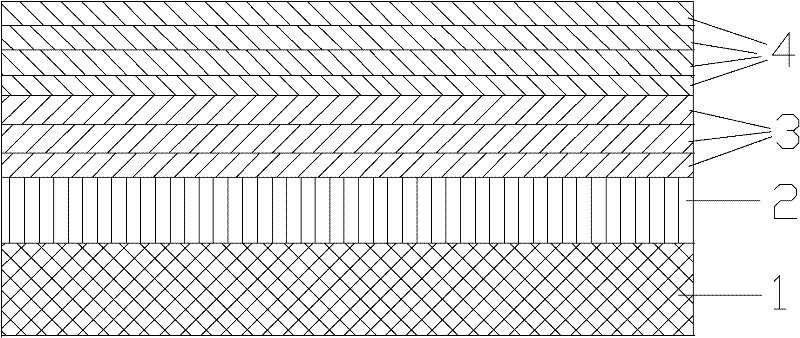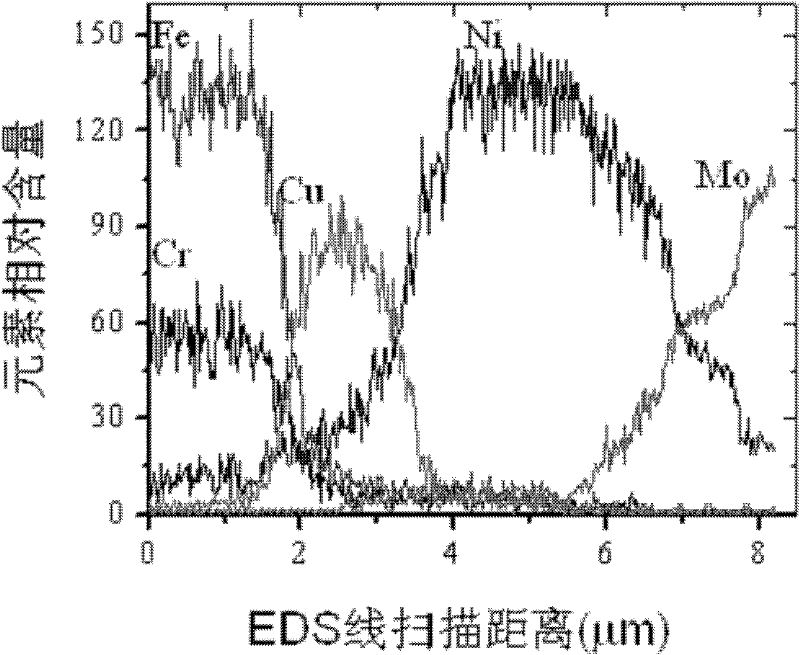Flexible metal substrate connected with back electrode of solar battery and fabrication method thereof
A technology of solar cells and flexible metals, applied in circuits, electrical components, climate sustainability, etc., can solve the problems of changing the metering ratio of elements in the absorbing layer, difficult to control the diffusion amount and uniformity, and unfavorable for large-scale industrial production , to achieve the effect of reducing material cost and manufacturing cost, improving battery production yield, and short preparation time
- Summary
- Abstract
- Description
- Claims
- Application Information
AI Technical Summary
Problems solved by technology
Method used
Image
Examples
Embodiment 1
[0044] A stainless steel strip with a thickness of 0.2 mm and a roughness of 0.2 μm was selected as the substrate.
[0045] Pre-plating surface pretreatment on the steel strip, that is, degreasing, pre-nickeling treatment. Oil removal is high-temperature chemical oil removal, sodium hydroxide 70g / L, sodium carbonate 40g / L, sodium phosphate 25g / L, sodium silicate 10g / L, temperature 80°C, oil removal for 3 minutes. After degreasing is complete, rinse the surface of the sample with distilled water, and then put it into a pre-nickel plating tank for pre-plating with a layer of nickel to improve the bonding force. Nickel chloride is 240g / L, concentrated hydrochloric acid is 120ml / L, and the current density is 3A. / dm 2 , pre-plating for 1 min.
[0046] Put the treated steel strip into a copper plating tank, and electroplate a 2 micron thick copper plating layer on one side. Copper plating conditions, copper sulfate 180g / L, concentrated sulfuric acid 55g / L, chloride ion 70mg / L, e...
Embodiment 2
[0050] A stainless steel strip with a thickness of 0.10 mm and a roughness of 0.3 was selected as the substrate.
[0051] Surface pretreatment of steel strip before plating. Processing method is identical with embodiment 1.
[0052] Put the treated steel strip into a copper plating bath, and electroplate a 1 micron thick copper plating layer on one side. Plating solution composition copper sulfate 200g / L, concentrated sulfuric acid 60g / L, chloride ion 45mg / L, ethylenediaminetetraacetic acid 65g / L, temperature 30°C, current density 4A / dm 2 .
[0053] A multi-layer nickel coating with a total thickness of 6 microns was electroplated on the copper coating by means of ultrasonic electroplating in a Watts nickel plating solution without brightener. In the continuous electroplating production line, the nickel plating layer with multi-layer structure is obtained by increasing the number of nickel plating tanks. In this example, 5 watt nickel plating tanks are set, and the plating...
Embodiment 3
[0056] A stainless steel strip with a thickness of 0.10 mm and a roughness of 0.2 was selected as the substrate.
[0057] Surface pretreatment of steel strip before plating. The method is the same as in Example 1.
[0058] Put the treated steel strip into a copper plating tank, and electroplate a 3 micron thick copper plating layer on one side. Copper plating conditions, copper sulfate 200g / L, concentrated sulfuric acid 65g / L, chloride ion 50mg / L, ethylenediaminetetraacetic acid 60g / L, temperature 30°C, current density 3A / dm 2 .
[0059]Electroplate 2 layers of nickel plating on top of the copper plating, with a total thickness of 3 microns. The nickel coating is prepared in a nickel sulfamate bath. In this example, 3 plating tanks are set, and the plating solution in each plating tank is the same, the plating solution formula: nickel sulfamate 380g / L, nickel chloride 10g / L, boric acid 40g / L, process parameters: current density 4A / dm 2 , pH value 4.0, temperature 55°C, an...
PUM
| Property | Measurement | Unit |
|---|---|---|
| Current density | aaaaa | aaaaa |
| Thickness | aaaaa | aaaaa |
Abstract
Description
Claims
Application Information
 Login to View More
Login to View More - R&D
- Intellectual Property
- Life Sciences
- Materials
- Tech Scout
- Unparalleled Data Quality
- Higher Quality Content
- 60% Fewer Hallucinations
Browse by: Latest US Patents, China's latest patents, Technical Efficacy Thesaurus, Application Domain, Technology Topic, Popular Technical Reports.
© 2025 PatSnap. All rights reserved.Legal|Privacy policy|Modern Slavery Act Transparency Statement|Sitemap|About US| Contact US: help@patsnap.com



